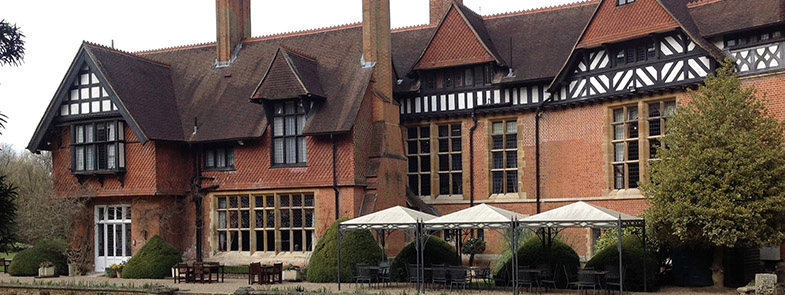Built in 1870, Grims Dyke was designed by Richard Norman Shaw. Shaw was renowned for blending old and new styles of architecture and Grims Dyke was a testament to this. The design and subsequent build of Grims Dyke, successfully proved his theory that old English architecture was compatible with modern ideas of comfort and style.
Grims Dyke was created in the Late-Elizabethan style with Gothic revivalism add to this. Stylistically, this early renaissance architecture comprised elements of both Tudor and Jacobean styling – resulting in a red-bricked and timber building, with high red-tiled gables, tall clustered chimneys and leaded lights.
The stone bridges within the grounds of Grims Dyke, along with the terrace walls of the tennis court, show influence of the old stone walls around Hampshire. Shaw lay red brick, worked stone and unchipped flint in irregular courses of thick mortar, to create these walls. He sourced the working stone from Harrow Church in Stanmore, as it was currently being restored.
The great chimney-piece in the drawing room was created from Cornish alabaster. It was designed by Ernest George and based on one of W.S. Gilbert’s own sketches. It is still an eye-catching piece of art, still in its original location, albeit now known as the music room. This elaborate carved piece consists of carved fruit, garlands and flowers. There’s two grinning drunken Roman Woodland Gods (or satyrs) supporting the main mantel, with several Greek caryatids (draped female figures), acting as supports for the top piece.
The dining room has a high timbered roof, again showing a Cornish influence. This used to be the old studio, and could, in part explain why such a high roof, similar in style to the cradle or waggon roofs of old Cornish churches.
Another interesting piece is the oak sideboard in the drawing room. Jacobean in origin, it was originally made in 1631 for Sir Thomas Holte. Holte was the 1st Baronet and owner of Aston Hall – a Jacobean country house in Birmingham.
With the creation of the great chimney-piece, Gilbert illustrated his own artistic flair. This was further illustrated by his need to personally rearrangement the kitchen department!
Gilbert had a desire for the landscaped gardens to accurately reflect the natural beauty of nature. He relished the autumn leaves falling on gravelled paths and actively encouraged both the white pigeons into his garden and the wild rabbits to scurry across the, otherwise neatly trimmed, lawns – something other well-to-do gentlemen would not understand. He also added a variety of exotic animals and plants into the grounds – each illustrating his love of travel and his flair for something different. It’s therefore only fitting that Gilbert found the tranquillity and peace he desired, here at Grims Dyke – a house of varied and different architectural influence.


